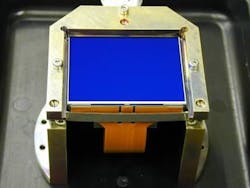CCD SENSORS: 150 e2v imaging sensors delivered for Gaia
Chelmsford, England--e2v has delivered 150 CCD imaging sensors for Gaia, a European Space Agency (ESA) mission that will be the largest focal-plane array ever flown in space.
Due to launch in 2012, Gaia's goal is to map the positions, parallaxes and proper motions (movement across the sky) of around 1 billion objects in our galaxy to an unprecedented accuracy. For the brightest objects, radial velocities (movement towards and away from the satellite) will be measured and photometric data taken to determine the composition of the objects. The result of this will be the most detailed map of the Milky Way ever produced.
Synchronous operation
At the heart of these astrometric, spectroscopic, and photometric instruments is the largest focal-plane array ever to be flown in space. This focal-plane array will contain a mosaic of 106 large area, high performance, custom, back-thinned e2v CCD91-72 imaging sensors. The CCDs will be operated synchronously in TDI mode, effectively working as a near-gigapixel array.
There are three variants of the CCD91-72, each optimized for different wavelengths in the range 250 to 1000 nm. The CCD packages are three-sided buttable, to minimize the dead space between CCDs when they are tiled together in the mosaic.
Having completed the design and extensive evaluation of these CCDs, e2v is now close to completing manufacture and test. More than 150 devices have now been delivered during the flight phase of the project, comprising of flight models, flight spares, and engineering models. These are currently being integrated by the satellite prime contractor, EADS Astrium, to form what will be the focal-plane array ahead of the proposed 2012 launch.
"Gaia continues a European tradition for pioneering astrometry, building on the expertise generated by the first space-based astrometry mission, Hipparcos," said Giuseppe Sarri, project manager of GAIA at ESA. "Gaia will outdo its predecessor in terms of accuracy, limit magnitude, and number of objects. It will pinpoint the position of stars with an accuracy on the order of 10 to 300 microarcseconds."
About the Author
John Wallace
Senior Technical Editor (1998-2022)
John Wallace was with Laser Focus World for nearly 25 years, retiring in late June 2022. He obtained a bachelor's degree in mechanical engineering and physics at Rutgers University and a master's in optical engineering at the University of Rochester. Before becoming an editor, John worked as an engineer at RCA, Exxon, Eastman Kodak, and GCA Corporation.

